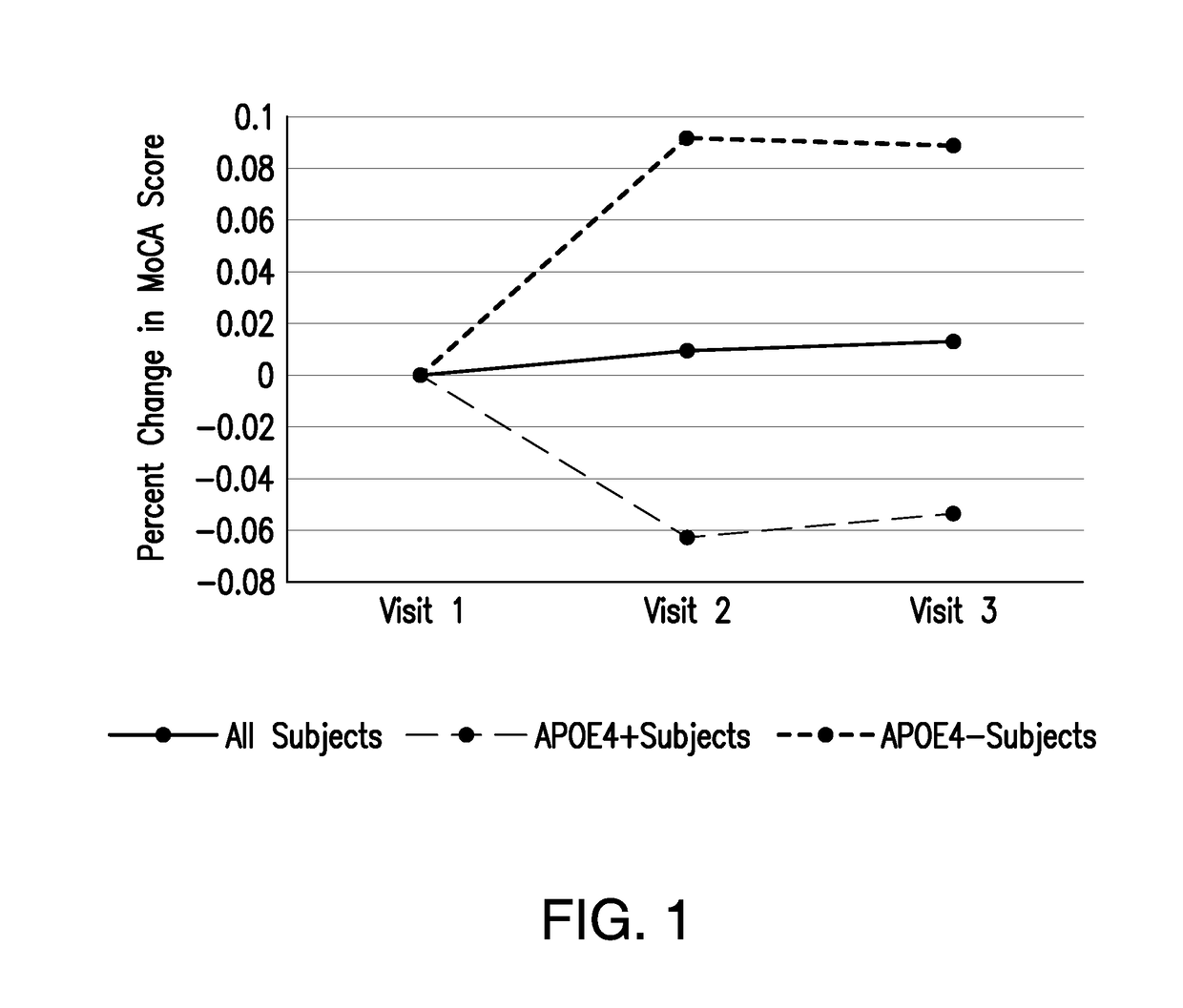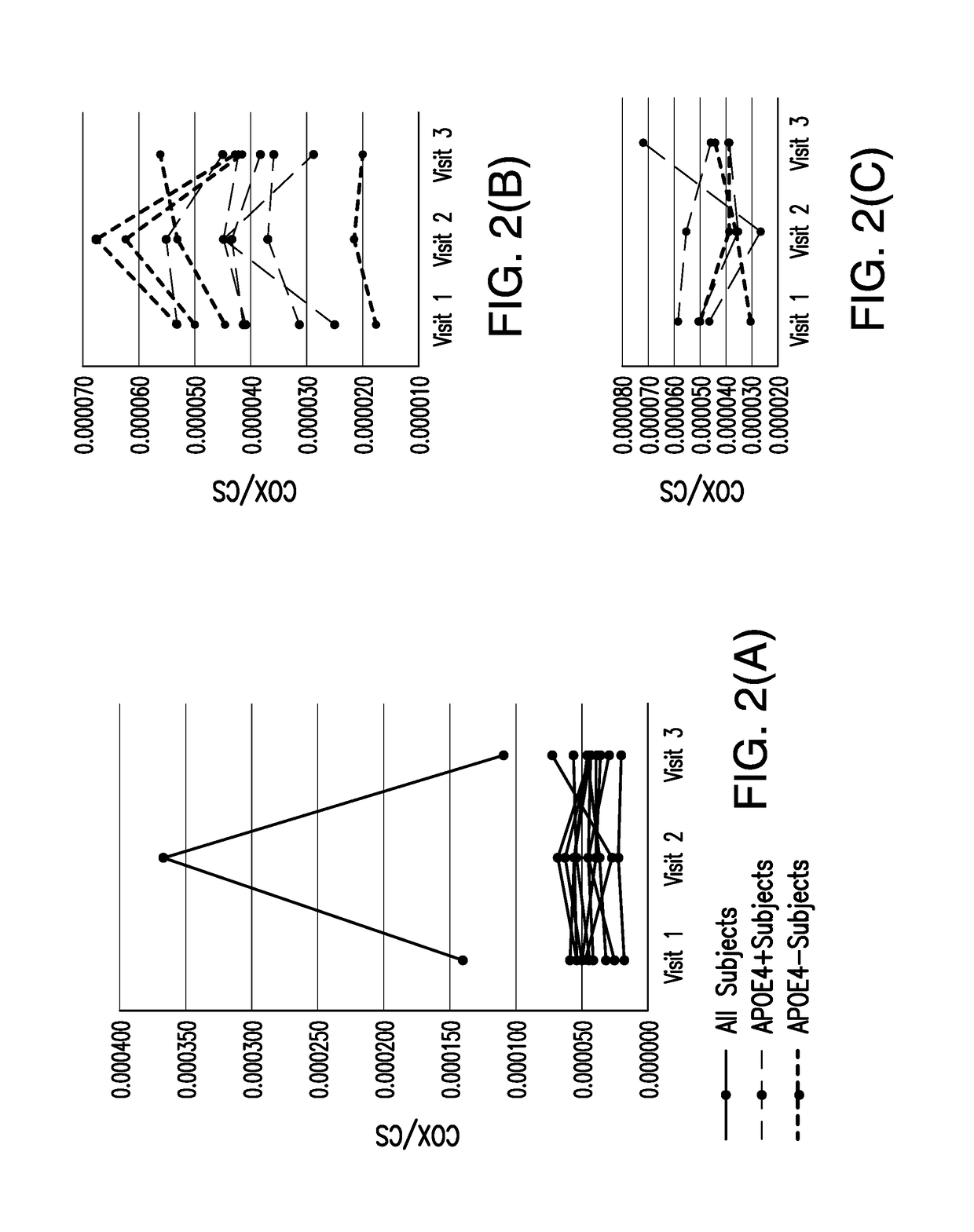Methods of diagnosing and treating alzheimer's disease with s-equol
a technology of alzheimer's disease and sequol, applied in the direction of drug compositions, transferases, instruments, etc., can solve the problems of too late approach, costing our economy $385 billion annually, and affecting the social li
- Summary
- Abstract
- Description
- Claims
- Application Information
AI Technical Summary
Benefits of technology
Problems solved by technology
Method used
Image
Examples
example 1
Obtaining Blood Samples and Measuring Enzyme Activity
[0065]Forty milliliter blood samples were collected in tubes containing acid-citrate-dextrose (ACD) tubes as an anticoagulant, and maintained at room temperature. Within 24 hours of phlebotomy the blood was processed by the ADC Mitochondrial Genomics and Metabolism Core. To initiate the processing procedure, platelets were isolated by centrifugation and enriched mitochondrial fractions prepared using previously described methods. Such procedures involved nitrogen cavitation to rupture platelets followed by centrifugation to collect mitochondria.
[0066]The protein concentrations of the enriched mitochondrial fractions were measured using a BCA protein assay kit (BioRad, Hercules, Calif.). COX Vmax activity was determined as a pseudo first order-rate constant (sec-1 / mg) by measuring the oxidation of reduced cytochrome c at 550 nm.
[0067]In addition to measuring COX activity, each sample's citrate synthase (CS) Vmax activity (nmol / min / ...
example 2
Outcomes
[0068]An S-equol-associated modification of platelet mitochondria COX activity was designated as the primary outcome measure. To determine whether an S-equol-associated change in platelet mitochondrial COX activity occurred for an individual participant, an anticipated pattern of response analysis was used. It was expected that platelet mitochondria COX activity would increase in response to the active treatment.
[0069]Participants were identified as responding (i.e., increasing COX activity in response to treatment, classified as “successes” or “responders”) if the individual change (slope) from the lead-in measurement to the active treatment measurement was greater than the change (slope) from the active-treatment measurement to the wash-out (visit 3) measurement.
[0070]Secondary outcomes included a safety analysis of the S-equol 10 mg twice per day dose and an analysis of MoCA scores. Although APOE genotype did not inform subject selection, a post-hoc, secondary analysis of...
example 3
Montreal Cognitive Assessment (MoCA) of APOE4 Carriers and Non-Carriers
[0071]A total of 16 participants were enrolled, of which 15 participants completed the study. Data from the other participant was not included in any analysis. Of the 15 subjects, 8 were APOE4 carriers (7 with an APOE3 / 4 genotype, 1 with an APOE2 / 4 genotype), and 7 were non-APOE4 carriers (all 7 had an APOE3 / 3 genotype).
[0072]Age means and MoCA score ranges are shown in Table 1. Ages between APOE4 carriers and non-carriers were not significantly different.
TABLE 1Participant APOE status, ages, and MoCA ranges.AgeMoCANumber of(Mean ±AgeBaseline ParticipantsSEM)(Range)(Range)Total1573.5 ± 2.062-896-25APOE4 Carriers870.9 ± 2.263-827-25APOE4 non-776.4 ± 3.462-896-17Carriers
[0073]No adverse events occurred and compliance approached 100%. Mean MoCA scores were similar between visits (Table 2). No significant differences were observed between visits, or between APOE4 carriers and non-carriers.
TABLE 2MoCA scores.MoCAMoCAM...
PUM
| Property | Measurement | Unit |
|---|---|---|
| membrane potential | aaaaa | aaaaa |
| cell energy production | aaaaa | aaaaa |
| mitochondrial mass | aaaaa | aaaaa |
Abstract
Description
Claims
Application Information
 Login to View More
Login to View More - R&D
- Intellectual Property
- Life Sciences
- Materials
- Tech Scout
- Unparalleled Data Quality
- Higher Quality Content
- 60% Fewer Hallucinations
Browse by: Latest US Patents, China's latest patents, Technical Efficacy Thesaurus, Application Domain, Technology Topic, Popular Technical Reports.
© 2025 PatSnap. All rights reserved.Legal|Privacy policy|Modern Slavery Act Transparency Statement|Sitemap|About US| Contact US: help@patsnap.com



